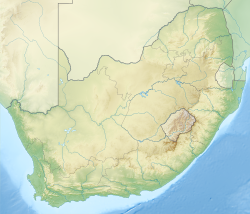KAT-7

KAT-7 in 2014
|
|
| Location(s) |
Northern Cape |
|---|---|
| Coordinates | 30°43′16″S 21°24′40″E / 30.721°S 21.411°ECoordinates: 30°43′16″S 21°24′40″E / 30.721°S 21.411°E |
| Organization |
NRF Department of Science and Technology SKA South Africa Project |
| Altitude | 1,100 m (3,600 ft) |
| Wavelength | radio 3 centimetres (1.2 in) to 30 centimetres (12 in) |
| Built | 2010 |
| First light | 2009 |
| Telescope style | dish |
| Diameter | 12 m (39 ft 4 in) |
| Collecting area | ~2,000 square metres (22,000 sq ft) in KAT-7 |
| Focal length | 26 m to 185 m |
| Website | www |
|
|
|
|
[]
|
|
|
|
KAT-7 is a radio telescope constructed in the Northern Cape of South Africa. Part of the Karoo Array Telescope project, it is the precursor engineering test bed to the larger MeerKAT telescope, but it has become a science instrument in its own right. The construction was completed in 2011 and commissioned in 2012. It also served as a technology demonstrator for South Africa's bid to host the Square Kilometre Array. KAT-7 is the first Radio telescope to be built with a composite reflector and uses a stirling pump for 75 K cryogenic cooling. The telescope was built to test various system for the MeerKAT array, from the ROACH correlators designed and manufactured in Cape Town, now used by various telescopes internationally, to composite construction techniques. With the short baselines the telescope is suited to observing diffuse sources, but will begin VLBI observation in 2013.
KAT-7 consist of 7 dishes of 12 metres in diameter each a Prime Focus Reflecting telescope.
MeerKAT supports a wide range of observing modes, including deep continuum, polarisation and spectral line imaging, pulsar timing and transient searches. A range of standard data products are provided, including an imaging pipeline. A number of "data spigots" are also available to support user-provided instrumentation. Significant design and qualification efforts are planned to ensure high reliability in order to achieve low operational cost and high availability.
In April 2010 four of the seven dishes were linked together as an integrated system to produce its first interferometric image of an astronomical object. In Dec 2010, there was a successful detection of very long baseline interferometry (VLBI) fringes between the Hartebeesthoek Radio Astronomy Observatory's 26 m dish and one of the KAT-7 dishes.
...
Wikipedia

